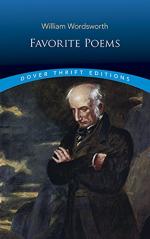|
This section contains 490 words (approx. 2 pages at 400 words per page) |

|
Ode: Intimations of Immortality From Recollections of Early Childhood Summary & Study Guide Description
Ode: Intimations of Immortality From Recollections of Early Childhood Summary & Study Guide includes comprehensive information and analysis to help you understand the book. This study guide contains the following sections:
This detailed literature summary also contains Quotes and a Free Quiz on Ode: Intimations of Immortality From Recollections of Early Childhood by William Wordsworth.
The version of the poem used to create this study guide appears in: Applebaum, Stanley, editor. English Romantic Poetry: An Anthology. Dover Publications, Inc., 1996. Parenthetical citations within the guide refer to the lines of the poem from which the quotations are taken.
"Ode: Intimations of Immortality from Recollections of Early Childhood" is a long-form lyric ode written by William Wordsworth in the early 19th century. The piece was at first composed in two parts, the first four stanzas originally consisting of its own poem, ending with two questions that Wordsworth would later answer with the addition of the final seven stanzas. The poem was first published in Poems, in Two Parts in 1807 under the title "Ode," and later republished in 1815 with the longer title.
The final poem, composed of 11 stanzas and over 200 lines in length, is an exploration of the process of aging and its impact on the individual's ability to perceive the world around them. The text begins with the speaker in the first two stanzas lamenting their inability to see the wonder in the world the same way they once did as a child. While nature gives the speaker momentary reprieve from this overriding sense of grief, the speaker remains distraught by this loss of a spiritual connection with the outer world, and wishes to know where this visionary ability has gone. In the fifth stanza the speaker lays out the way in which the soul enters the world through the body, and this initial purity of the soul untouched by the physical world makes it possible for children to have an unparalleled connection with nature. However, as they mature and innocence gives way to experience, they gradually lose this ability.
Stanzas six through eight continue to elaborate on this loss of vision as the speaker wallows in what they perceive as an inevitable and harsh reality. However, in the final three stanzas their perspective shifts and they become more optimistic. The speaker begins to see the experiences of childhood as the building blocks upon which their entire life is built. Though the speaker is older now, they are still essentially the same person who once perceived such glory in the world. They take comfort in the fact that even in their maturity, they can still look back on their childhood and remind themselves of this connection to their younger self, and though they may not be able to view the world as they once did, they have still maintained a deep emotional connection with and love for nature.
Consistent with Wordsworth's other works, "Ode: Intimations of Immortality from Recollections of Early Childhood" focuses on ideas surrounding nature, humanity, and the power one can find in an imaginative relationship with the world. The irregularity in the lyric's structure, namely the varied stanza lengths, line lengths, meters, and rhyme schemes, represent a sense of artistic and poetic freedom, for which the piece is much celebrated.
Read more from the Study Guide
|
This section contains 490 words (approx. 2 pages at 400 words per page) |

|



